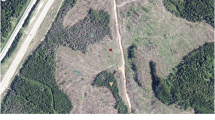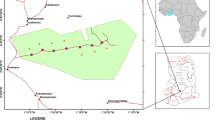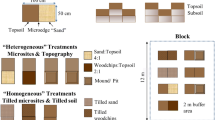Abstract
Although disturbance is known to alter soil nutrient heterogeneity, it remains unclear whether spatial patterns in soil nutrients after disturbance follow predictable temporal changes that reflect underlying processes. This study examined the effects of tree harvesting and girdling on overall variability, geostatistical patterns, and resource congruence of soil available nutrients in a mature Pinus elliottii Engelm. forest. The two disturbances led to different patterns of vegetation removal, forest floor redistribution, and revegetation, but showed similar post-disturbance changes in overall soil nutrient variability. Soil nutrient variability increased after both disturbances by more than 5-fold, and then decreased, returning to the undisturbed level in 4 years. Spatial structures assessed using geostatistics did not show predictable temporal trends. However, girdled plots showed more persistent spatial structures in soil nutrients than harvested plots, and had semivariogram ranges mostly equal to or less than 10 m, reflecting effects of persistent and spatially stable patches of undisturbed hardwoods that had an average patch size of 10 m. Resource congruence examined with Spearman rank correlations was nil before disturbance, increased after disturbance and then became nil again by the 4th year post-disturbance. The timing of the increase was related to treatment, occurring in the 1st year after disturbance in the girdled plots, but not until the 2nd year in the harvested plots. These two patterns of congruence were potentially caused by different rates of nutrient patch formation and resource uptake by plants during early succession. Although temporal changes in soil heterogeneity have been documented previously, the present study indicates that temporal trends in nutrient variability after disturbance may be predictable, and that the marked changes in spatio-temporal patterns of soil nutrients as a result of disturbance are ephemeral.




Similar content being viewed by others
References
Armesto J, Pickett STA, McDonell MJ (1991) Spatial heterogeneity during succession: a cyclic model of invasion and exclusion. In: Kolasa J, Pickett STA (eds) Ecological heterogeneity. Ecological studies 86. Springer, Berlin Heidelberg New York, pp 257–269
Beatty SW (1984) Influence of microtopography and canopy species on spatial patterns of forest understory plants. Ecology 65:1406–1419
Bell G, Lechowicz MJ, Appenzeller A, Chandler M, Deblois E, Jackson L, Mackenzie B, Preziosi R, Schallenberg M, Tinker N (1993) The spatial structure of the physical environment. Oecologia 96:114–121
Bliss KM, Jones RH, Mitchell RJ, Mou Pu (2002) Are competitive interactions influenced by spatial nutrient heterogeneity and root foraging behavior? New Phytol 154:409–417
Cain ML, Subler S, Evans JP, Fortin M-J (1999) Sampling spatial and temporal variation in soil nitrogen availability. Oecologia 118:397–404
Carlton GC, Bazzaz FA (1998) Resource congruence and forest regeneration following an experimental hurricane blowdown. Ecology 79:1305–1319
Clinton BD, Baker CR (2000) Catastrophic windthrow in the southern Appalachians: characteristics of pits and mounds and initial vegetation responses. For Ecol Manage 126:51–60
Cui M, Caldwell MM (1997) Shading reduces exploitation of soil nitrate and phosphate by Agropyron desertorum and Artemisia tridentata from soils with patchy and uniform nutrient distributions. Oecologia 109:177–183
Davis JC (1986) Statistics and data analysis in geology. Wiley, New York
Ehrenfeld JG, Han X, Parsons WFJ, Zhu W (1997) On the nature of environmental gradients: temporal and spatial variability of soil and vegetation in the New Jersey Pinelands. J Ecol 85:785–798
Einsmann JC, Jones RH, Mou P, Mitchell RJ (1999) Nutrient foraging in ten southeastern coastal plain plant species. J Ecol 87:609–619
Farley RA, Fitter AH (1999) Temporal and spatial variation in soil resources in a deciduous woodland. J Ecol 87:688–696
Fransen B, Kroon HD, Berendse F (2001) Soil nutrient heterogeneity alters competition between two perennial grass species. Ecology 82:2534–2546
Grime JP (1979) Plant strategies and vegetation processes. Wiley, Chichester, UK
Gross KL, Pregitzer KS, Burton AJ (1995) Spatial variation in nitrogen availability in three successional plant communities. J Ecol 83:357–367
Guo D, Mou P, Jones RH, Mitchell RJ (2002) Temporal changes in spatial patterns of soil moisture following disturbance: an experimental approach. J Ecol 90:338–347
Halvorson JJ, Bolton H Jr, Smith JL, Rossi RE (1994) Geostatistical analysis of resource islands under Artemisia tridentata in the shrub-steppe. Great Basin Nat 54:313–328
Isaaks EH, Srivastava RM (1989) Applied geostatistics. Oxford University Press, New York
Jackson RB, Caldwell MM (1993a) The scale of nutrient heterogeneity around individual plants and its quantification with geostatistics. Ecology 74:612–614
Jackson RB, Caldwell MM (1993b) Geostatistical patterns of soil heterogeneity around individual plants. J Ecol 81:683–692
Jones RH, Mitchell RJ, Stevens GN, Pecot SD (2003) Controls of fine root dynamics across a gradient of gap sizes in a pine woodland. Oecologia 134:132–143
Kleb HR, Wilson SD (1997) Vegetation effects on soil resource heterogeneity in prairie and forest. Am Nat 150:283–298
Li H, Reynolds JF (1995) On the quantification of spatial heterogeneity. Oikos 73:280–284
Lister AJ, Mou P, Jones RH, Mitchell RJ (2000) Spatial patterns of soil and vegetation a 40-year-old slash pine ( Pinus elliottii Engelm.) forest in the Coastal Plain of South Carolina, USA. Can J For Res 30:145–155
Mou P, Fahey TJ, Hughes JW (1993) Nutrient accumulation in vegetation following whole-tree harvest of a northern hardwood ecosystem. J Appl Ecol 30:661–675
Parsons WFJ, Knight DH, Miller SL (1994) Root gap dynamics in lodgepole pine forest: nitrogen transformations in gaps of different size. Ecol Appl 4:354–362
Pickett STA, White PS (1985) The ecology of natural disturbance and patch dynamics. Academic Press, San Diego
Pickett STA, Cadenasso ML, Jones CG (2000) Generation of heterogeneity by organisms: creation, maintenance and transformation. In: Hutchings MJ, John EA, Stewart AJA (eds) The ecological consequences of environmental heterogeneity. Blackwell Science, Oxford, pp 33–52
Pritchett WL, Fisher RF (1987) Properties and management of forest soils. Wiley, New York
Qian P, Schoenau JJ, Huang WZ (1992) Use of ion exchange membranes in routine soil testing. Commun Soil Sci Plan 23:1791–1804
Robertson GP, Gross KL (1994) Assessing the heterogeneity of belowground resources: quantifying pattern and scale. In: Caldwell MM, Pearcy RW (eds) Exploitation of environmental heterogeneity by plants. Academic Press, Boston, pp 237–252
Robertson GP, Crum MA, Ellis BG (1993) The spatial variability of soil resource following long-term disturbance. Oecologia 96:451–456
Rogers VA (1988) Soil survey of Savannah River Plant area, parts of Aiken, Barnwell, and Allendale counties, South Carolina. USDA, Aiken, South Carolina, USA
Rossi RE, Mulla DJ, Journel AG, Franz EH (1992) Geostatistical tools for modeling and interpreting ecological spatial dependence. Ecol Monogr 62:277–314
Ryel RJ, Caldwell MM, Manwaring JH (1996) Temporal dynamics of soil spatial heterogeneity in sage-brush-wheatgrass steppe during a growing season. Plant Soil 184:99–309
Schenk HJ, Jackson RB (2002) Rooting depths, lateral root spreads, and belowground /aboveground allometries of plants in water limited ecosystems. J Ecol 90:480–494
Schroeer AE, Hendrick RL, Harrington TB (1999) Root, ground cover, and litterfall dynamics within canopy gaps in a slash pine ( Pinus elliottii Engelm.) dominated forest. Ecoscience 6:548–555
Silver WL, Vogt KA (1993) Fine root dynamics following single and multiple disturbances in a subtropical wet forest ecosystem. J Ecol 81:729–738
Stark J (1994) Causes of soil nutrient heterogeneity at different scales. In: Caldwell MM, Pearcy RW (eds) Exploitation of environmental heterogeneity by plants. Academic Press, Boston, pp 255–282
Tilman D (1988) Plant strategies and the dynamics and structure of plant communities. Princeton University Press, Princeton
Vinton MA, Burke IC (1995) Interactions between individual plant species and soil nutrient status in shortgrass steppe. Ecology 76:1116–1133
Webster R, Oliver MA (1990) Statistical methods in soil and land resource survey. Oxford University Press, Oxford
Wijesinghe DK, John EA, Beurskens S, Hutchings MJ (2001) Root system size and precision in nutrient foraging: responses to spatial pattern of nutrient supply in six herbaceous species. J Ecol 89:972–983
Wilcznski CJ, Pickett STA (1993) Fine root biomass within experimental canopy gaps: evidence for a below-ground gap. J Veg Sci 4:571–574
Zheng L, Silliman SE (2000) Estimating the theoretical semivariogram from finite numbers of measurements. Water Resour Res 36:361–366
Acknowledgements
Support for this work came from the USDA NRI Grants 96-35101-3452 and 99-35101-7872, the USDA Forest Service Savannah River Station and Virginia Polytechnic Institute and State University. We thank Andy Lister, Amy Osorio, and John Peterson for field and laboratory assistance. Dr. Rob Jackson and an anonymous reviewer provided valuable suggestions that immensely improved the previous versions of this manuscript. Dr. Harbin Li provided insightful statistical and conceptual advice.
Author information
Authors and Affiliations
Corresponding author
Electronic Supplementary Material
Rights and permissions
About this article
Cite this article
Guo, D., Mou, P., Jones, R.H. et al. Spatio-temporal patterns of soil available nutrients following experimental disturbance in a pine forest. Oecologia 138, 613–621 (2004). https://doi.org/10.1007/s00442-003-1473-3
Received:
Accepted:
Published:
Issue Date:
DOI: https://doi.org/10.1007/s00442-003-1473-3




